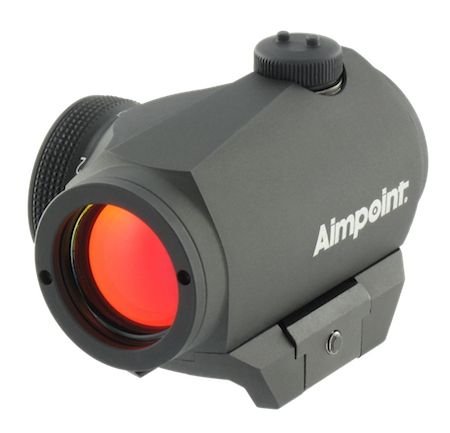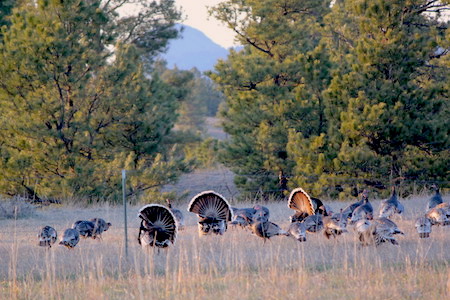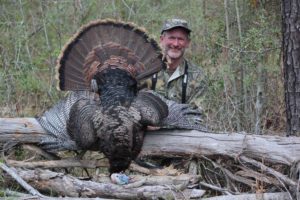Bob Robb's new Mossberg 500 FLEX produced this pattern at 40 yards with a Trulock .650 Long Beard choke tube and Winchester Long Beard 1200 fps 1 ¾ oz. No. 6 load using the 20-inch barrel.
It may be winter, but in my mind I can already hear gobblers gobbling on the roost. And so I’ve been getting everything ready for spring. This year I picked up a new Mossberg 500 FLEX pump shotgun in anticipation of a serious gobbler assault.
The 500 FLEX is a great choice for several reasons.

The author mounted this red dot sight to his turkey gun which, along with 144 turkey loads through two barrels and four different choke tubes, aided in his confidence and readiness to take a bird at 40 yards.
First off, it’s affordable. In fact, the Aimpoint Micro H-1 red dot sight I mounted on the Mossberg costs way more than the shotgun itself. Not only does it have all the rugged, never fail, can’t break me features of Mossberg pump guns, but the FLEX TLS (Tool-less Locking System) is a series of three patent-pending connectors that allow shooters a simple method of switching stocks, forends and recoil pads for a variety of shooting applications. That means I can quickly and easily switch out forends to adjust the length of pull and add a cheek piece that makes the gun fit properly for use with an optic sight. This spring I’ll be guiding friends and family on several different hunts, and can set this gun up in an instant to fit everyone.
After setting the gun up to fit me, I gathered up all the turkey loads I could purchase at a local big box shooting and hunting store and head to the range. I also purchased three after-market turkey choke tubes (the gun came with a turkey tube) and had Mossberg send me an extra barrel, giving me both 20- and 24-inch barrels. In all I had eight different loads to shoot. By my calculations that means I had 36 different combinations to shoot, which means I actually shot 144 shots since I shot at both 20 and 40 yards, and fired two shots with each combination.
That’s a lot of big recoil, which I mitigated by shooting off the bench with the aid of a Champion Premium Shooting Rest weighed down with sandbags. It took me two days to get it done. Range conditions were ideal, no wind, low humidity and an air temperature of 55 degrees.
This is not meant to be an end-all test where I shot every imaginable aftermarket turkey choke and turkey load available. I was limited with what I could find locally. Since I’ve always liked to shoot 3-inch, 12 gauge shells loaded with No. 6 shot at turkeys, that’s what I tested (with the exception of one 2 ¾-inch load I happened to have at home). I also shied away from aftermarket choke tubes that cost an arm and a leg. You get the picture. The goal wasn’t to enter the NWTF’s World Still Target Championship, but to end up with a choke tube/load combination or two I felt confident enough in to kill any gobbler that came within 40 yards.
At the end of the day, I had a couple of super-deadly barrel/choke/load combinations to head afield with this spring.
Some salient points about my results

Wyoming Merriam's: Western turkey hunters often experience birds, like these Wyoming Merriam's, that hang up at extended ranges, just one reason why patterning your gun/load/choke tube combination is so important.
Different point of impact. The 20- and 24-inch barrels shot to a different point of impact, meaning I had to adjust the sight for each. (The sight mounts on the receiver, not the barrel, a feature I really like).
You never know until you test. Some loads liked the short barrel, some liked the long barrel, and some liked both barrels with the same choke tube. You never know until you shoot them.
Change begets change. Never forget that every time you change anything: barrel, choke tube, load (including shot size in the same load), or any combination thereof, the pattern will most certainly change.
Trap loads. Before shooting the test loads I used some light-recoiling trap loads to get the gun sighted in at 20 yards. That saved both expensive turkey loads and wear and tear on my shoulder.
Essentially, what I found was that most every load/choke/barrel combination pattern worked well enough to hunt with if shots are within 20 yards. And though I try and get gobblers in that magic 20-30 yard “zone” before I shoot, I want to make sure that in case I have to reach out to 40 yards my shotgun/load combination can get it done. Hence my pattern testing at both 20 and 40 yards. You know, hope for the best, prepare for the worst.
5 steps to help you evaluate how your turkey gun patterns different loads, and how to sight it in

Even in the dense cover of the Louisiana swamps, a turkey gun needs to throw a consistent, tight pattern. Robb took this Louisiana Eastern gobbler at 20 steps.
1) Shoot From A Solid Rest: Those 3-inch 12 gauge loads kick. Hard. Eliminate human error by using a shooting bench and a recoil-absorbing, fully-adjustable gun rest.
2) Use The Right Targets: Begin with inexpensive bull’s eye-type targets, then switch to using head and neck gobbler targets that show the spine and brain after the pattern is centered to the shotgun’s point of aim. I love the targets that show a glow-like splatter when hit, like the by Birchwood Casey Pre Game Gobbler Target, TRUGLO Tru-See Splatter Turkey Target , and Primos Visi Shot Turkey Head X-Ray Target.
3) Pattern From The Distances You Will Hunt: I pattern at 20 and 40 yards, and study each target carefully. I shoot several shots to confirm the pattern. When I’m happy with it, I make notes in my notebook as well as save the target.
4) Adjust Your Sights: Center your pattern just above the gobbler’s wattles. If it’s off, adjust the sights accordingly.
5) Record all your test shooting results in a notebook. I store both my notes and my best targets with my turkey loads so every spring I am reminded of what works best.
Test shooting results
To see an example of how Bob Robb tracks his shooting results and get the detail on how each combination performed, download the test chart for the Mossberg 500 Flex HERE.






